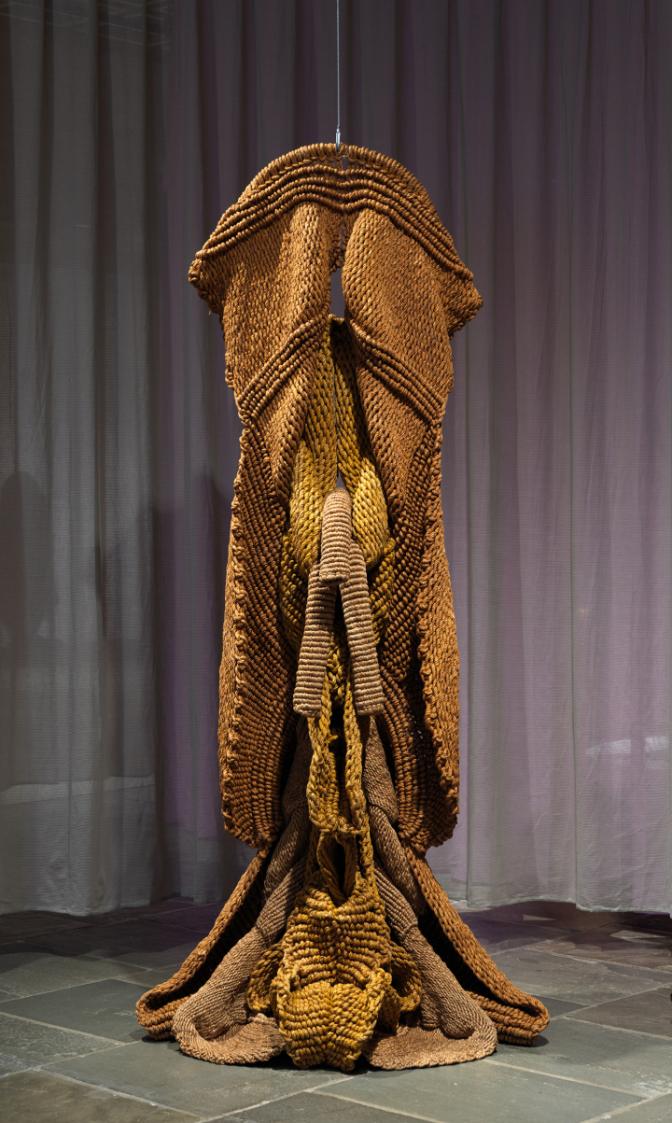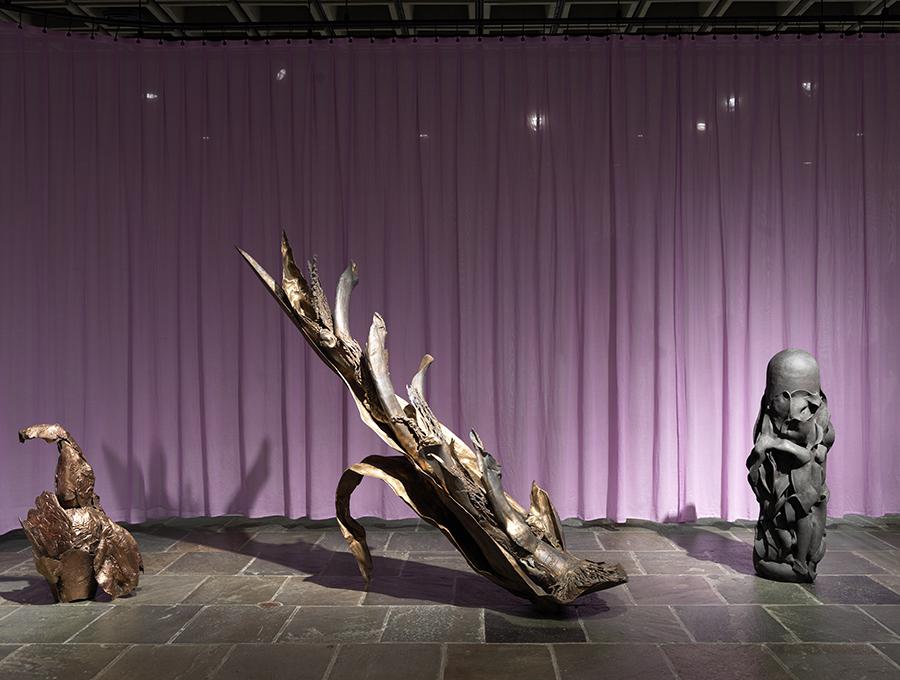What makes an artist modern? The question has long loomed over Mrinalini Mukherjee, an Indian artist who sat at the uneasy confluence of contemporary art and Indian folk aesthetics, never fully belonging to either world. Best known for colorful, hulking sculptures that pay homage to the natural world, Mukherjee was largely misunderstood in her lifetime. Now, she might be getting the recognition she’s long been due with her first retrospective in America.
Phenomenal Nature: Mrinalini Mukherjee, at New York’s Met Breuer through September 29, features nearly sixty of Mukherjee’s works. The first thing you might notice is the distinctiveness of her sculptures. Some are suspended from the wall, others sit on the floor, but all command attention with their bright yellows, verdant greens, and royal purples, blending botanical and anthropomorphic forms. They’re meticulously woven from jute, which the artist treated in a month-long process—wetting, uncurling, straightening, drying, and dyeing—before even beginning the sculpting process.
The tough material seems fitting of Mukherjee, whose strong-willed individualism can be sensed throughout her work. She appropriated the visual vocabulary of modernism to suit her own sensibilities. While a group of Western artists in the 1960s and ’70s turned to fiber art as a way of reconceiving modernism, Mukherjee wasn’t aware of their contributions. Nor did she fit into the post-Independence Indian art world, which was dominated by irreverent male figure painters. Instead, Mukherjee, independent, hermitic, and meticulous, worked in near isolation in India, by the northwestern region of Bengal.
Mukherjee was born into an artistic family in Bombay; both her parents were painters, and her father taught at a school that honored the teachings of the great Indian writer and artist Rabindranath Tagore. In her youth, Mukherjee would have been hard to miss. She had a jubilant demeanor—round face, thick-rimmed black glasses, big, toothy smile. One portrait features Mukherjee in her twenties, shiny black hair in a long braid, laughing while holding a cigarette. After attending art school, Mukherjee became well-versed both in modern art and traditional Indian folk art. She was fascinated by regional crafts and local textiles, which might account for her heavy emphasis on the material physicality of her work. Individually knotting her sculptures, without the help of machines or modern technology, was laborious. Mukherjee’s process required profound attention to detail—tying the jute one knot at a time, meticulously shaping the fiber so it would fit her sculptural vision and still hold its own weight (her husband was her chief assistant). The decades in which Mukherjee worked in India were marked by modernization and technological advancement, but the artist focused more on her own sacred relationship to nature.

Walking through the Met Breuer, this sense of transcendence is evident. The exhibit is smartly curated, minimalistic in its design. There are no large placards with explanatory text; there aren’t even titles next to the sculptures. Instead, visitors receive royal purple brochures upon entrance, allowing them to check the name of the piece and learn a little background—if desired. This frees you to engage with the viscerality of the sculptures without being bogged down by context. The whole floor is dimly lit and has a mystical feeling, almost like walking through a jungle populated by colorful, whimsical beasts. The sculptures become more intricate and impressive as the show progresses; the pieces are mainly organized chronologically, and Mukherjee’s deftness with the difficult materials increased with time. Woman on Peacock is a particularly striking work; it was both Mukherjee’s first fully freestanding sculpture, and one of her most figural. In deep purple, orange-accented hues, it features a broad-shouldered feminine form atop a masculine figure, touching on themes of both animality and sexuality. Another, Adi Pushp II (Primal Flower), is a saturated flora which blooms in fiery shades, interwoven black hinting at decay.
Many of Mukherjee’s early sculptures share names with Hindu fertility goddesses. There’s Basanti (She of Spring), an imposing form woven from a blend of jute dyed in earthy brown and orange tones. It’s flaccid and fleshy and at its center is a trio of bright tubular forms. There are also two sculptures entitled Devi: one is black and ominous, with sinister serpentine curves. The other, vaguely feminine in shape, with warm yellow-orange hues, has a more welcoming aura. Viewed together, they express the duality of the Hindu goddess Devi’s nature: she’s both a source of great reverence —“Jaganmata,” mother of the universe—and the cause of pervasive destruction, a force in perpetual battle.
The Met displays these sculptures separately, though, perhaps in part to underscore that Mukherjee’s references to the divine aren’t meant to be taken as literally religious. “My idea of the sacred is not rooted in any specific culture,” she said in a 1994 interview. “To me it is a feeling that I may get in a church, mosque, temple, or forest.” Mukherjee’s work hints at the spirituality of Rabindranath Tagore, who spent time with Bengali Bauls (anti-caste musical minstrels who preached a universal spirituality) and was known for a personal commitment to interreligious harmony. But over the course of the 1990s, a period of heightened religious tensions in India, Mukherjee’s nods to goddesses came to be seen as folksy religious art, and her critical stature waned. Things weren’t much better abroad. In the United Kingdom, the work was merely fetishized for its exotic “otherness.” This was consistent with the way many British critics at the time perceived Indian art: regressive and indigenous, perpetually behind the cutting edge of European modernism.
Still, the reception of her work was of little concern to Mukherjee. She only desired to create, regardless of what obstacles came her way. Working with ropes was physically demanding and obtaining the necessary dyes increasingly difficult, so Mukherjee began experimenting with new materials—ceramics, stoneware, bronze. Her ceramic sculptures are smoother and glossier, playfully reflecting light. Some are imaginatively hued, like Blue Work I, a non-figural work with twisted, earthen coils accented by deep sapphire and turquoise. Like many of her sculptures, it possesses a sense of vegetal harmony; Mukherjee was greatly inspired by the intelligent designs found in plant life, and the rhythms and textures of organic matter. While many Indian artists at the time were concerned with inclusion in the international art scene, or with addressing the violent, politically fraught legacies of independence and the partition of the Indian subcontinent, Mukherjee produced art that was self-contained. It’s simultaneously contemporary and traditional, and so transcends the tensions forged by religion and border in post-independence India.

Mukherjee hints at death and decay throughout her oeuvre, but by the end of her career seemed to ruminate on it. Several bronze works, a “Palmscape” series, are particularly arresting. They’re a poignant conclusion to the artist’s career—the last one was completed in 2015, shortly before Mukherjee’s passing. It’s titled Palmscape IX; the bronze is fashioned into a palm tree that curls up on itself, its roots writhing, as if forced from its home to an unfamiliar place. The bronze, intricately fashioned, is itself starting to tarnish, which only adds to the feeling of mourning.
Mrinalini Mukherjee may not have received the attention or acclaim she deserved during her lifetime. And yet, revisiting her work now seems fitting, especially as her native India enters a new frontier in its national identity. There and around the world, tensions arising from differences in ethnicity, class, and creed are escalating. Mukherjee brings us back to what binds us: shared animalistic roots, a common humanity; our simultaneous wonder and fear of the divine; the “feeling” of being in a place of worship, or in nature’s wilderness. The sense of what it means to be alive.
Please email comments to [email protected] and join the conversation on our Facebook page.
Share
Previous Story
Francis and the Spirit of Fraternity
Next Story
Pulling up the Ladder